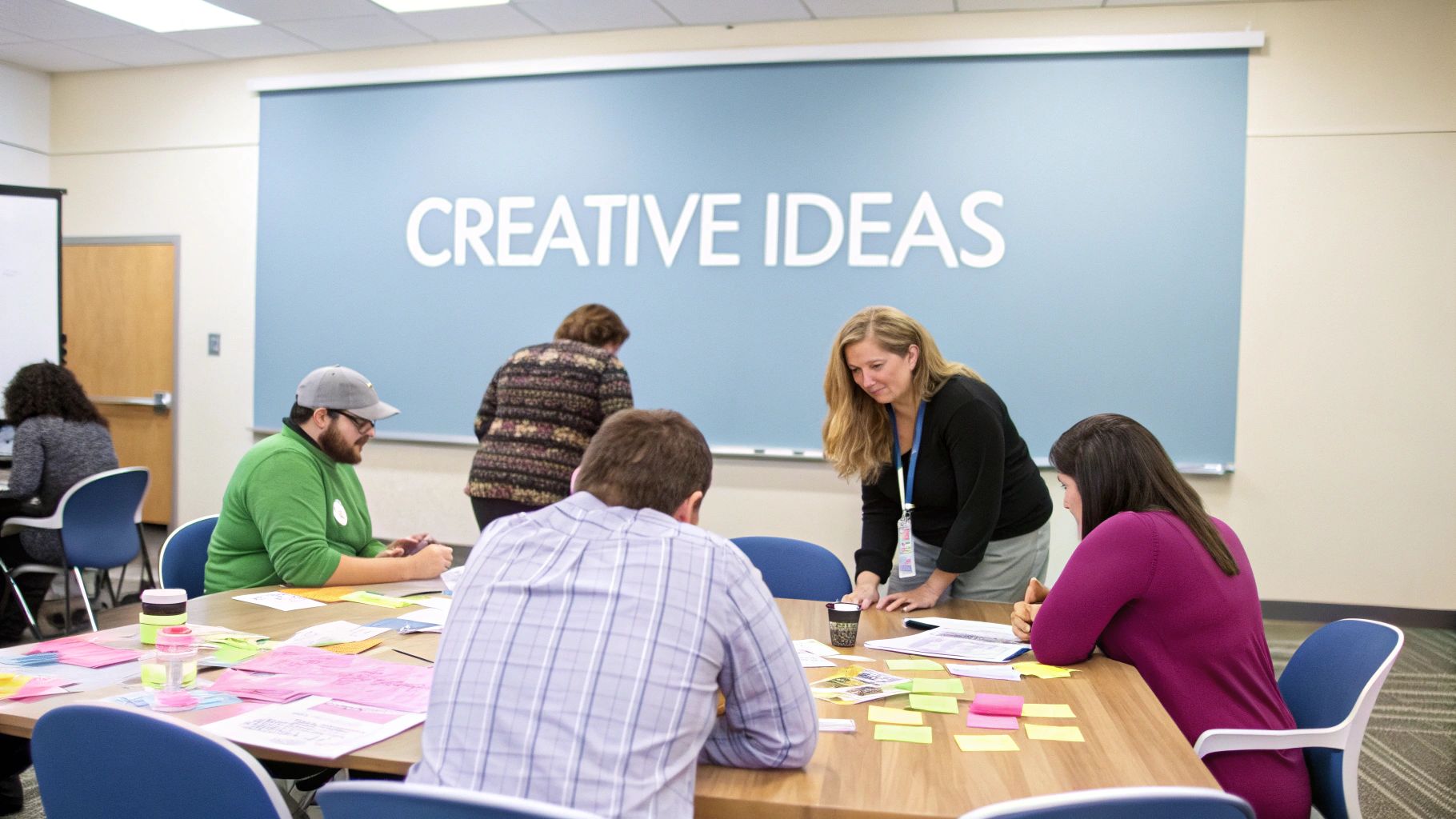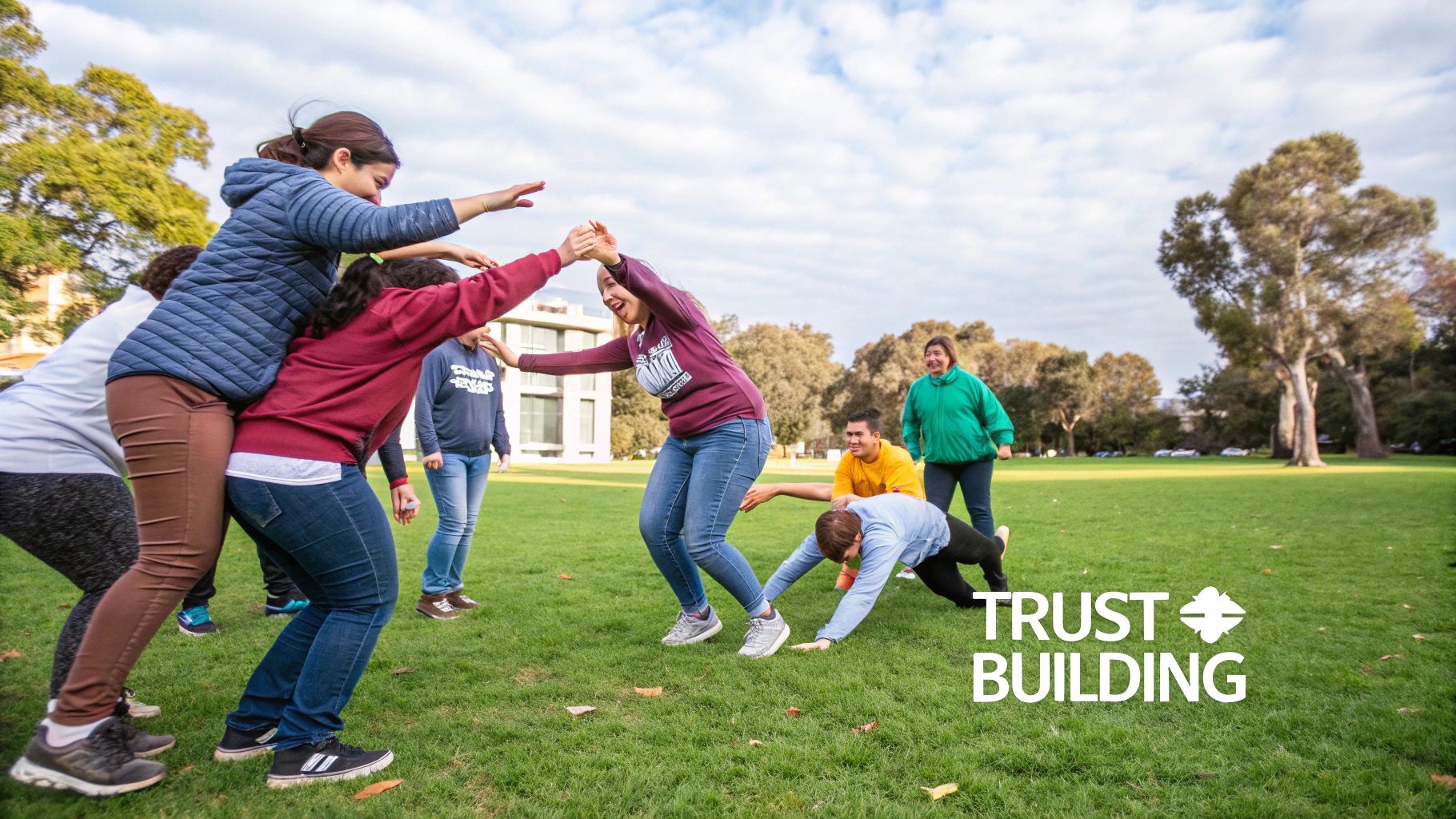Why Team Building Activities Matter More Than Ever
Team building isn't just about getting out of the office anymore - it's become essential for building strong teams that work well together. When done right, these activities help create trust, improve collaboration, and give teams the tools they need to tackle challenges together. Let's explore why team building matters now more than ever!
The Science Behind Effective Team Building
Research shows that well-designed team activities create lasting positive changes in how teams work together. Structured activities don't just bring people closer - they help team members truly understand and connect with each other. The result? Better job satisfaction and higher employee retention.
Here's the thing: old-school team building focused too much on quick fun without creating real change. Modern approaches dig deeper by blending personal growth with team wellbeing. Adding social elements helps reduce stress at work and gets people talking more openly with each other.
Communication: A Key Component
When teams participate in social activities together, their communication improves dramatically. A fascinating study in the Harvard Business Review found that dedicated team practices can boost communication by up to 50%! This happens because informal settings let people relax and share ideas more freely. Want to learn more about how team building improves workplace communication? Check out these fascinating insights from Surface Office's team building research.
Real Success Stories That Inspire
Many companies have seen amazing changes after implementing strategic team building programs. The most successful ones focus on clear goals, create a sense of belonging, and track results carefully. When done right, this leads to more engaged employees and better productivity.
Here's what makes team building work:
- Set clear goals for each activity
- Choose activities that match your team's needs
- Measure results and make improvements
- Use feedback to plan future activities
When teams embrace effective team building, they create stronger connections and work better together. These connections become the foundation for ongoing success and growth.
Building Emotional Intelligence Through Team Activities

Team building isn't just about having fun - it's a fantastic way to develop emotional intelligence (EQ) skills that create stronger teams! When teams participate in engaging activities together, they naturally build their EQ muscles while strengthening relationships and collaboration.
Why Focus on Emotional Intelligence?
Emotional intelligence is a game-changing skill set that helps us understand ourselves and connect with others. The key parts include self-awareness (knowing your own emotions), self-regulation (managing those emotions), motivation, empathy, and social skills. For example, a self-aware team member knows their strengths and blind spots, while an empathetic one genuinely understands their colleagues' perspectives. These abilities are absolutely essential for working well with others and building great workplace relationships.
Activities That Boost EQ
Want some exciting ways to build EQ? Here are some team activities that target different aspects of emotional intelligence:
- Blindfolded Obstacle Course: Build trust and communication as teammates guide each other through challenges. This develops both social skills and empathy.
- Group Problem-Solving Challenges: Things like escape rooms or puzzle-solving get teams collaborating while managing emotions under pressure.
- Role-Playing Scenarios: Practice real workplace situations to build empathy and better handle tricky interpersonal dynamics.
- Feedback and Reflection Sessions: Take time after activities to discuss what happened and learn from the experience as a group.
Integrating EQ Development Into Your Team Building Strategy
The key to success is choosing activities that match your team's needs and goals. Be clear about what you want to accomplish, and create an environment where everyone feels comfortable growing together. Research shows that 90% of top performers have high EQ, and it can boost job performance by 58%. Learn more about the latest approaches on team building trends. When you thoughtfully plan activities and make time for reflection, you'll create a team culture where emotional intelligence and collaboration thrive.
Virtual Team Building Activities That Drive Real Connection

Building authentic connections in remote teams takes creativity and intention. The good news? Virtual team building activities can create meaningful bonds between colleagues, even across distances. When done right, these online experiences can be just as impactful as in-person gatherings.
Fun Virtual Activities That Work
Many successful remote companies have discovered activities that truly bring teams together. Here are some proven favorites that create real connections:
- Virtual Escape Rooms: Teams work together to crack codes and solve puzzles, building collaboration skills naturally through shared challenges
- Online Game Nights: Group games create laughter and friendly competition that helps coworkers relax and connect
- Digital Workshops: Learning new skills together, whether it's cooking, art, or professional development, creates shared experiences and conversation starters
Want to dive deeper into workplace relationships? Check out our guide on building authentic workplace connections.
Making Virtual Events a Success
Getting everyone involved across time zones takes some planning. These tips can help:
- Mix Up Meeting Times: Alternate schedules so everyone gets convenient time slots
- Keep Activities Simple: Choose games and activities that work well for all skill levels and tech setups
- Quick Connect Sessions: Brief, casual video chats help maintain team bonds between bigger events
Good preparation and clear communication help these activities run smoothly. When facilitators set the right tone, teams naturally engage and connect.
Seeing What Works
It's important to know if your virtual team building efforts are hitting the mark. Tracking participation and gathering honest feedback tells you what resonates with your team. Simple surveys after events help measure engagement and identify ways to improve.
Companies find the best results come from blending technology with genuine human connection. When virtual activities focus on authentic interaction, teams develop real rapport despite physical distance. For more insights on strengthening remote team bonds, explore our full article on workplace connection strategies.
With thoughtful virtual team building, physical distance doesn't have to mean emotional distance. The right activities can create a vibrant remote culture where everyone feels connected.
Problem-Solving Activities That Transform Team Dynamics

Want to take your team's collaboration to the next level? Problem-solving activities are an amazing way to strengthen teamwork while having fun. These exercises create a safe space where teams can practice critical thinking and work together to overcome challenges. The best part? The skills learned directly translate to better performance at work.
Designing Engaging Problem-Solving Activities
The most impactful activities mirror real workplace scenarios that teams face. For instance, having a team work together to plan a marketing campaign with limited resources teaches valuable budgeting and prioritization skills. When teams tackle familiar challenges in a low-pressure environment, they develop practical experience they can immediately apply to their daily work.
Facilitation Techniques for Maximum Impact
Having a skilled facilitator makes all the difference in problem-solving exercises. The facilitator guides without directing, asks thought-provoking questions, and ensures everyone has a voice. The post-activity debrief is where real growth happens - teams reflect on what worked, what didn't, and how to apply those insights going forward.
Examples of Effective Problem-Solving Activities
Ready to get started? Here are some proven team activities that build problem-solving muscles:
- Escape Rooms: Teams must work together to solve puzzles and decode clues within a time limit. Perfect for practicing quick thinking and delegation.
- Lost at Sea Challenge: Teams rank items salvaged from a shipwreck by survival importance. Tests prioritization and consensus-building under pressure.
- Building Challenges: Using basic materials like straws and tape, teams compete to build the tallest structure. Develops creativity and resource management skills.
Measuring and Tracking Improvement
To get the most from these activities, track how they impact team performance over time. Use observation, feedback surveys, and project outcomes to measure growth. Regular assessment helps prove the value of team building and lets you fine-tune activities for even better results. The data shows what's working and highlights areas where teams can keep improving.
Scaling Team Building Success Across Organization Sizes
Getting team building activities right for different sized organizations makes all the difference in their success. Whether you're bringing together a small startup team or energizing hundreds of corporate employees, smart adjustments help create engaging and meaningful experiences. Take scavenger hunts for example - their effectiveness comes from thoughtful adaptation to your specific group dynamics, not just scaling up or down.
Making Activities Work for Different Group Sizes
1. Small Teams (3-10 People):
- The Magic of Small Groups: Intimate settings naturally boost individual connections and personal growth
- Perfect Activities: Try blindfolded obstacle courses or escape room challenges - they build trust and communication in a fun way
- Real Example: A startup might use role-playing during meetings to work through business scenarios together
2. Mid-Sized Teams (11-20 People):
- Sweet Spot Size: These groups hit the perfect balance between individual participation and team dynamics
- Go-To Activities: Run group problem-solving challenges or the classic egg drop to spark creativity and strategic thinking
- Added Bonus: These activities naturally create team bonding moments
3. Large Teams (20+ People):
- Big Group Benefits: Larger corporate teams bring diverse skills and viewpoints that enrich activities
- Winning Activities: Community service projects or group mural painting unite people around shared goals
- Pro Tip: Break into smaller sub-teams when needed for deeper engagement
Smart Ways to Keep Costs and Time in Check
You don't need a big budget or tons of time for great team building. Simple, effective approaches work well - like using office supplies you already have. Activities such as office trivia or photo challenges are quick to set up and get everyone involved without spending much.
Making Activities Work at Any Scale
No matter your team size, focus on clear goals, flexibility, and open communication. Even a quick 5-minute activity can expand into something bigger by adding group discussion afterward.
- Set specific goals that match what your team needs
- Ask for feedback to make future sessions even better
- Mix up activities to match different learning styles
When you scale activities thoughtfully, every team member gets to shine. Good planning helps build stronger communication, deeper connections, and higher team spirit across your whole organization. Check out how tools like Neroia can help make team experiences even better, no matter your group size.
Measuring and Maximizing Team Building ROI
Want to make sure your team building activities deliver real results? Just like any investment, team building needs to show clear returns. Let's explore how to measure and boost your team building ROI through data-driven strategies that create lasting positive change.
Identifying Key Performance Indicators (KPIs)
To measure success, first define what matters most. Here are the key Performance Indicators (KPIs) to track:
- Better Communication: Monitor how well teams share information, listen actively, and handle conflicts after activities
- Higher Productivity: Track completion rates, efficiency, and output to see improvements
- Sharper Problem-Solving: Measure how quickly and creatively teams tackle challenges together
- Stronger Team Unity: Use surveys to assess trust levels, respect, and mutual support
- Better Staff Retention: Watch how team building connects to keeping great people on board
Gathering and Analyzing Data
Once you pick your KPIs, collect meaningful data through:
- Before & After Surveys: Compare team dynamics and skills before and after each activity
- Performance Numbers: Look at project completion, customer satisfaction, and sales data
- 360-Feedback: Get input from all levels - peers, managers, and reports
- Direct Observation: Watch team interactions during activities to spot behavior patterns
Using Data to Optimize Team Building Activities
Keep checking your data regularly to find what needs improving. If surveys show an activity isn't helping communication, try a different approach. For example, maybe your team loved working together on a survival scenario but didn't click with building challenges. Use these insights to pick better activities.
This data-focused strategy helps prove the real value of team building to leadership. When you can show clear links between activities and business goals, team building becomes a vital growth tool, not just a fun extra.
Ready to take your team building to the next level with smart data insights? Neroia can help transform how your teams work together. Visit our website to learn more.
Article created using Armox AI




